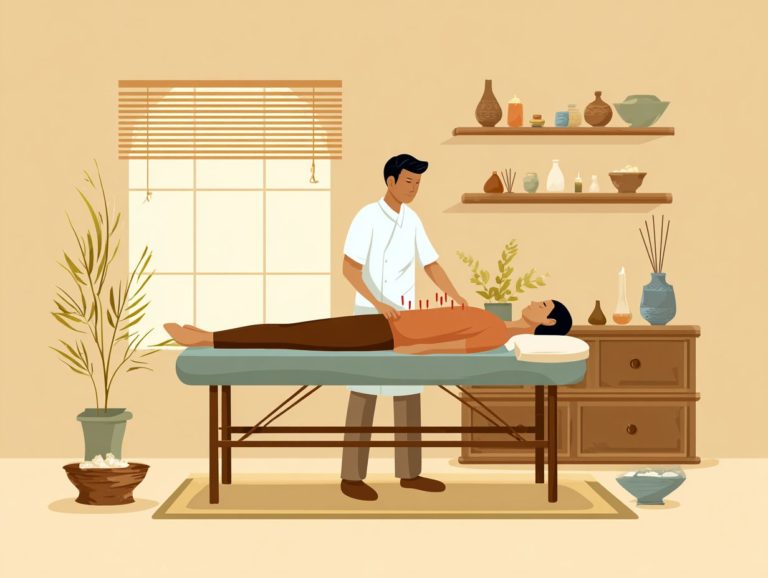Acupuncture: Pain Relief Uses, Techniques, and Effectiveness
Acupuncture, an ancient practice rooted in Traditional Chinese Medicine, has gained recognition worldwide for its potential to alleviate pain.
This article explains the basics of acupuncture, describing how it operates and the methods used during therapy.
It examines the specific types of pain it can address, from chronic pain to headaches, and discusses its benefits, such as reducing inflammation and improving blood flow.
The effectiveness of acupuncture is reviewed based on research and patient experiences, guiding on what to expect during a session.
Key Takeaways:
Contents
- 1 What is Acupuncture?
- 2 How Does Acupuncture Work for Pain Relief?
- 3 What Types of Pain Can Acupuncture Help With?
- 4 What Are the Benefits of Acupuncture for Pain Relief?
- 5 How Effective is Acupuncture for Pain Relief?
- 6 Acupuncture Pain Relief Effectiveness
- 6.1 Effect Sizes and Usage Statistics: Effect Sizes versus No Acupuncture Control
- 6.2 Effect Sizes and Usage Statistics: Effect Sizes versus Sham Acupuncture
- 6.3 Effect Sizes and Usage Statistics: Population Statistics
- 6.4 What Do Studies Say About Acupuncture’s Effectiveness?
- 6.5 What Do Patients Say About Acupuncture’s Effectiveness?
- 6.6 Are There Any Side Effects of Acupuncture for Pain Relief?
- 7 What to Expect During an Acupuncture Session?
- 8 Frequently Asked Questions
- 8.1 What is acupuncture and how does it help with pain relief?
- 8.2 What types of pain can acupuncture help with?
- 8.3 Are there different techniques used in acupuncture for pain relief?
- 8.4 How effective is acupuncture for pain relief?
- 8.5 Is acupuncture safe for pain relief?
- 8.6 How many sessions of acupuncture are needed for pain relief?
What is Acupuncture?

Acupuncture is an old Chinese medicine technique used for thousands of years to help with various health issues. It involves inserting needles at certain points on the body to stimulate energy flow and balance the body’s life force.
This practice believes that good health relies on the smooth movement of energy, called Qi, through channels in the body, and blockages in this movement can lead to discomfort and long-lasting pain.
How Does Acupuncture Work for Pain Relief?
Acupuncture helps ease pain by triggering the body’s own healing abilities and supporting energy movement, which can help control long-lasting pain and ease discomfort.
This method uses careful placement of tiny needles into certain spots on the body to release endorphins, which are the body’s own pain-relieving chemicals, and to improve blood flow to the areas in need. Research published by Frontiers in Neuroscience explores the effects and mechanisms of acupuncture analgesia, providing a deeper understanding of how these processes work.
What Are the Techniques Used in Acupuncture?
Acupuncture uses different methods to improve treatment, such as acupuncture needles, moxibustion, and electrical stimulation. Each method is specifically designed for the patient’s health condition and treatment plan, using disposable needles for safety and reducing pain during the needle insertion.
Moxibustion, which involves the burning of the herb mugwort near specific acupuncture points, is often used to warm and invigorate the flow of Qi within the body. This technique can be especially beneficial for conditions that are categorized as ‘cold’ in traditional Chinese medicine, helping to relieve pain and promote healing.
Electrical stimulation can be applied to acupuncture needles during a session. This adds a mild electrical current that helps with muscle relaxation and pain relief.
Thorough patient assessments are essential before deciding which acupuncture methods are most suitable, ensuring that the treatment provided aligns with individual health needs and goals.
What Types of Pain Can Acupuncture Help With?
Acupuncture can help with different types of pain, providing relief for issues like ongoing pain, muscle pain, headaches, joint pain, and discomfort during menstrual cycles.
It can also help people with breathing problems by improving energy flow and supporting overall health.
Can Acupuncture Help with Chronic Pain?
Yes, acupuncture can significantly help individuals manage chronic pain by addressing the root causes and restoring balance within the body’s energy flow. Studies show that acupuncture can reduce pain, help patients respond better, and offer lasting relief for those with ongoing pain.
In recent years, an increasing number of peer-reviewed clinical trials have emerged, highlighting acupuncture’s potential as a viable alternative to conventional pain relief methods. This aligns with findings from JAMA Internal Medicine, which provides a comprehensive analysis of acupuncture for chronic pain through individual patient data.
Research in medical journals has shown that acupuncture can greatly improve symptoms of osteoarthritis and fibromyalgia when included in patient treatment plans.
Many people have shared stories about how acupuncture relieved their pain and made daily tasks easier.
The combination of strong evidence and patient stories highlights why acupuncture should be viewed as a recognized method for dealing with long-term pain.
Can Acupuncture Help with Headaches and Migraines?
Acupuncture has been found to be an effective treatment for headaches and migraines, providing discomfort relief by stimulating the nervous system and promoting relaxation. By targeting specific acupuncture points, this method can reduce how often and how severe headaches are, making it a helpful part of a full pain management plan.
Key acupuncture points for headache treatment include:
- LI4 (Hegu), located between the thumb and index finger
- GB20 (Fengchi), found at the base of the skull
Research indicates that activating these areas can improve blood flow and reduce tightness in muscles, which helps ease headaches. Patients often report experiencing significant reductions in their headache symptoms after just a few sessions, with some even noting longer-lasting effects.
Research indicates that acupuncture can be effective in treating severe headaches and might also prevent recurring migraines. This makes it a useful option alongside other treatments.
Can Acupuncture Help with Arthritis Pain?
Acupuncture can be a beneficial treatment option for individuals suffering from arthritis pain, offering discomfort relief and improving overall joint function. This traditional Chinese medicine method focuses on certain acupuncture points to improve energy flow and lessen swelling, helping to ease ongoing pain linked to arthritis.
By stimulating these points, acupuncture promotes the release of endorphins, the body’s natural painkillers, and encourages blood circulation, which can help to nourish the joints and improve mobility.
Research suggests that acupuncture may also modulate the immune response, potentially leading to reduced swelling and stiffness often experienced in arthritic joints.
Used alongside standard arthritis treatments, it offers patients a complete way to manage their symptoms and feel better overall.
Can Acupuncture Help with Menstrual Cramps?
Acupuncture can effectively alleviate menstrual cramps by promoting energy flow and addressing the underlying causes of discomfort. By focusing on certain acupuncture points linked to the reproductive system, this treatment helps manage menstrual pain and improves the entire menstrual cycle.
During an acupuncture session, practitioners typically focus on key points such as SP6 (Spleen 6), CV4 (Conception Vessel 4), and LV3 (Liver 3). Acupuncture improves blood flow, lowers swelling, and balances hormones by targeting specific areas.
This natural approach quickly eases cramping and helps manage irregular cycles over time. Women often report experiencing reduced intensity of cramps, a decrease in related symptoms such as bloating and mood swings, and an overall sense of well-being.
Adding acupuncture to a well-rounded treatment plan can help women manage their menstrual health, providing an effective way to relieve discomfort.
What Are the Benefits of Acupuncture for Pain Relief?

Acupuncture helps with pain by lowering inflammation, triggering endorphin release, increasing blood circulation, and easing muscle tightness.
These healing effects make it a popular method for treating different types of pain, chosen by both acupuncture experts and individuals looking for natural ways to manage pain.
Reduces Inflammation
One of the key benefits of acupuncture is its ability to reduce inflammation, which is often a primary contributor to pain conditions and discomfort. By targeting specific acupuncture points, this practice can modulate the body’s inflammatory response, leading to significant pain relief and an overall improvement in health.
Research suggests that acupuncture can increase the release of substances that reduce inflammation and at the same time lower the levels of substances that cause inflammation. For those interested in a comprehensive overview, this analysis by Frontiers in Immunology covers the full spectrum of acupuncture’s anti-inflammatory effects, particularly at the ST36 point.
A study published in the Journal of Inflammation Research highlighted that regular acupuncture treatments resulted in lower levels of tumor necrosis factor-alpha (TNF-), a well-known inflammatory mediator.
Acupuncture might help your body produce endorphins, which are chemicals that relieve pain, adding to its positive effects on health.
These biological processes work together to help people have less inflammation, better movement, and improved health. This makes acupuncture a helpful addition in dealing with long-term pain conditions.
Stimulates the Release of Endorphins
Acupuncture stimulates the release of endorphins, the body’s natural painkillers, providing effective pain relief and a sense of well-being. This process occurs through nervous system stimulation when acupuncture needles are inserted at specific points, triggering biochemical responses that diminish pain perception.
Studies show that certain acupuncture points, like LI4 (Hegu) and PC6 (Neiguan), are important for relieving pain. When these points are targeted, the nervous system responds by releasing endorphins, which directly interact with the brain’s pain pathways, enhancing a sense of comfort.
Studies have shown that patients undergoing acupuncture frequently report lower levels of chronic pain and improved mood, supporting its effectiveness as a complementary treatment.
Acupuncture uses the body’s own ways of relieving pain to reduce discomfort and improve general health, showing its importance in complete health care practices.
Improves Blood Flow
Acupuncture improves blood flow to targeted areas, facilitating the healing process and alleviating pain. Better blood flow lowers muscle tension and helps essential nutrients and oxygen get to the areas that need them, helping with recovery and comfort.
Many studies have shown a link between acupuncture and better blood flow, proving that this old technique can successfully trigger the body’s natural healing processes.
A study in the Journal of Pain Relief found that people who got acupuncture treatment had less pain and could move better. Patient testimonials support these results, with individuals sharing how they felt stronger and more energetic after sessions.
This increased blood flow helps reduce swelling and speeds up healing, highlighting acupuncture’s potential benefits in managing pain and recovery.
Relieves Muscle Tension
Acupuncture effectively relieves muscle tension, a common source of pain and discomfort in many individuals. By focusing on specific acupuncture points, this treatment can relieve muscle tension, improve flexibility, and promote relaxation, leading to noticeable pain relief.
For those suffering from chronic conditions, the benefits of this ancient practice extend beyond immediate relief. Regular sessions can help control the body’s reaction to pain, lower anxiety, and improve sleep, offering an all-around method to deal with ongoing discomfort.
People often say they use less pain medicine because acupuncture deals with the root cause instead of just covering up the symptoms. This method helps people feel better, letting them take back control of their bodies and live better lives.
How Effective is Acupuncture for Pain Relief?
The use of acupuncture to alleviate pain has been backed by many studies and recent research, highlighting its effectiveness as a treatment for different types of pain.
Clinical trials show that acupuncture can offer notable relief for people dealing with long-term pain, headaches, and arthritis, emphasizing its role in strategies to manage pain.
Acupuncture Pain Relief Effectiveness
Acupuncture Pain Relief Effectiveness
Effect Sizes and Usage Statistics: Effect Sizes versus No Acupuncture Control
Effect Sizes and Usage Statistics: Effect Sizes versus Sham Acupuncture

Effect Sizes and Usage Statistics: Population Statistics
The Acupuncture Pain Relief Effectiveness The data provides a detailed look at how well acupuncture works for different kinds of pain and also shows how its use is changing worldwide and in the United States. This information is important for learning about acupuncture’s part in today’s pain management.
Effect Sizes versus No Acupuncture Control highlight the impact of acupuncture on three pain conditions. For back and neck pain, an effect size of 0.55 suggests a moderate to high effectiveness compared to no treatment. Similarly, osteoarthritis shows an effect size of 0.57, indicating that acupuncture provides significant relief. Chronic headache exhibits an effect size of 0.42, demonstrating moderate effectiveness. These figures show that acupuncture could be a practical option instead of traditional pain relief methods.
In contrast, Effect Sizes versus Sham Acupuncture highlight the real advantages of genuine acupuncture treatment compared to placebo effects. The effect sizes for back and neck pain (0.23), osteoarthritis (0.16), and chronic headache (0.15) are lower compared to no treatment control, suggesting that while some benefits could be attributed to acupuncture, there is also a psychological component involved in pain relief.
- Population Statistics reveal significant growth in acupuncture’s popularity: a 120% increase in usage among U.S. adults from 2002 to 2022. This surge reflects greater acceptance and integration of acupuncture into mainstream healthcare. Acupuncture is also practiced in 103 countries, emphasizing its global reach and cultural significance.
- Despite this growth, only 2.2% of U.S. adults used acupuncture in 2022, indicating potential for further adoption within the population.
The data on Acupuncture Pain Relief Effectiveness highlights its moderate success in treating specific pain types, suggesting significant benefits beyond placebo effects. The growing use of acupuncture shows its increasing importance in worldwide health treatments, offering an additional method with traditional medical treatments.
What Do Studies Say About Acupuncture’s Effectiveness?
Many acupuncture studies have confirmed its success in relieving pain, especially for long-term pain issues like arthritis and fibromyalgia. Research findings consistently show that patients who undergo acupuncture treatment often report significant reductions in pain levels and improvements in overall well-being.
- A meta-analysis published in the Journal of Pain evaluated over 20 clinical trials and found that 70% of participants experienced at least a 30% reduction in pain following acupuncture sessions.
- A study focusing on chronic lower back pain suggested that those receiving acupuncture had a 50% greater improvement in their pain score compared to those who received standard care alone.
Patient testimonials highlight diverse experiences, with many individuals mentioning increased mobility, better sleep quality, and reduced reliance on pain medications.
This method addresses physical symptoms and improves emotional health, presenting acupuncture as a helpful additional treatment for ongoing pain relief.
What Do Patients Say About Acupuncture’s Effectiveness?
People react differently to acupuncture’s benefits, but lots of them say they feel better and have less pain. Testimonials from patients highlight the role of acupuncture in their pain management strategies, often indicating improved quality of life and reduced reliance on conventional painkillers.
These comments often highlight better movement, reduced anxiety, and an improved feeling of stability and health. Participants often mention a complete change, as acupuncture helps with their physical pain and supports their emotional and mental well-being.
Many people have talked about how regular sessions help them participate more in daily tasks, leading to a better sense of health and happiness. This detailed approach attracts people looking for options other than standard medicine, showing that more individuals are finding out how acupuncture can help with pain relief.
Are There Any Side Effects of Acupuncture for Pain Relief?
While acupuncture is generally regarded as a safe treatment option, there can be side effects and risks associated with the practice. Common side effects are small bruises and soreness at the needle insertion spots. In rare cases, there can be more serious issues, so it’s important to talk with a trained professional to get a treatment plan made just for you.
Improper cleaning or incorrect methods can lead to infections. You should ask a qualified expert for help.
People thinking about acupuncture should talk about their medical history, since some health issues might increase the risk of negative reactions.
Patients should make sure their acupuncturist uses clean needles and follows safety rules to improve the experience.
By focusing on the safety of acupuncture, people can reduce possible risks and fully experience the benefits of this traditional method.
What to Expect During an Acupuncture Session?
During an acupuncture session, patients start with a detailed first meeting, followed by treatments that are adjusted to their health needs. This may involve placing needles at certain points on the body.
Practitioners often set up a calming environment to help patients feel at ease, and focus on supporting a positive healing process through careful follow-up care.
Initial Consultation and Assessment
The first meeting and evaluation during an acupuncture session include a detailed examination of the patient’s health issues, daily habits, and past medical care. This important step lets the acupuncture specialist create a personalized treatment plan that focuses on the individual’s specific needs and improves their pain relief results.
During this foundational meeting, the practitioner typically begins by gathering detailed information through patient assessments, which include a thorough medical history and a discussion about current symptoms.
Questions are asked to learn about physical health issues as well as emotional and environmental influences that might affect health.
Initial checks, like examining your pulse and tongue, might be done to better understand the body’s energy flow, called Qi.
These parts combine to develop an effective strategy for managing issues like long-lasting pain, worry, and other health challenges, using a thorough method for healing.
Needle Insertion and Stimulation
Placing the needle is an essential part of the acupuncture session, where practitioners use thin, disposable needles to target certain points. While some patients may feel a minimal discomfort during the insertion, the technique is generally well-tolerated and contributes to the overall pain relief process.
Practitioners are trained to make sure the procedure is safe and works well by following strict hygiene rules. This uses sterile, disposable needles, which greatly lower the chance of infection and increase comfort during the process.
Most clients describe the sensation as a light pinch, similar to a mosquito bite, and any immediate discomfort typically dissipates quickly. Talking about worries early is important because clear communication can reduce stress and make things more comfortable.
Ultimately, using needles offers more benefits than the short-lived discomfort, making it important for health.
Relaxation and Aftercare

After the needle is placed, relaxing is important in an acupuncture session as practitioners encourage patients to let go and accept the healing. Proper aftercare is essential for maximizing benefits, as practitioners may provide guidance on post-session activities that promote patient comfort and overall well-being.
During these sessions, various relaxation techniques are employed, such as deep breathing exercises or guided meditation, which help calm the mind and body. Focusing on calmness helps reduce stress and supports the body’s natural healing process.
Aftercare practices, such as drinking plenty of water and avoiding heavy physical activities, help improve the patient’s recovery. These relaxation techniques and careful follow-up care greatly improve the success of acupuncture, supporting its use as a therapy that promotes physical and emotional well-being.
Frequently Asked Questions
What is acupuncture and how does it help with pain relief?
Acupuncture is a form of traditional Chinese medicine that involves inserting thin needles into specific points on the body to stimulate the body’s natural healing process. It is believed to help with pain relief by promoting the flow of energy, or qi, in the body and releasing endorphins, the body’s natural painkillers.
What types of pain can acupuncture help with?
Acupuncture can help with a variety of pain, including chronic pain, acute pain, and musculoskeletal pain. It has been shown to be effective in managing pain related to conditions such as arthritis, migraines, and back pain.
Are there different techniques used in acupuncture for pain relief?
Yes, there are various techniques used in acupuncture for pain relief, including traditional needle acupuncture, electroacupuncture, and acupressure. The specific technique used will depend on your individual needs and preferences, and may be determined by your acupuncturist.
How effective is acupuncture for pain relief?
Studies have shown that acupuncture can be an effective method for pain relief. It has been found to be particularly effective in managing chronic pain and may provide longer-lasting relief compared to traditional pain medications. The results of acupuncture can differ for each individual.
Is acupuncture safe for pain relief?
When performed by a trained and licensed acupuncturist, acupuncture is generally considered safe for pain relief. The needles used are sterile and single-use, reducing the risk of infection. Some people may experience mild side effects such as bruising or soreness at the needle insertion site, but these are typically temporary.
How many sessions of acupuncture are needed for pain relief?
The amount of acupuncture treatments required for pain relief depends on the person and how intense their pain is. Some people may experience relief after just one session, while others may require multiple sessions. Your acupuncturist will create a treatment plan based on your personal health and situation.

Sheetal Sharda has a background in CS. She got an interest in Holistic living back in 2018, and has since started exploring more into Naturapathy, Holistic Living, Yoga, and more. She got inspired to start SereneClinics to help people find reliable centers across the world.





